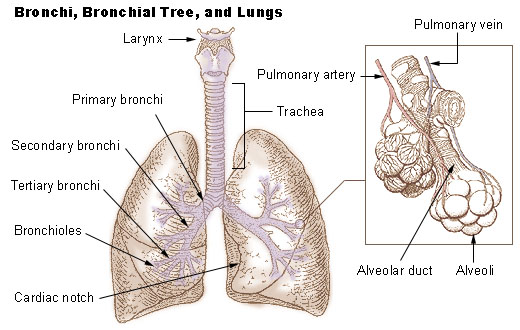Physiology of Respiration
Published (updated: ).

Pulmonary ventilation refers to the movement of air in and out of the lungs
Ventilation is defined as the movement of air in and out of the lungs. Patient with adequate ventilation are moving normal or near normal volumes of air into and out of the lungs.

The pulmonary capillary beds are where oxygen is taken into the body and carbon dioxide (CO2) is released into the atmosphere.

Oxygenation is the amount of blood that has been saturated with oxygen
Oxygenation refers to the amount of oxygen dissolved in the body and body fluids. Blood that is almost fully saturated with oxygen might be described as well-oxygenated blood.

Respiration is the process which the body captures and uses oxyen and disposes of carbon dioxide
The red blood cells being transported through the pulmonary capillaries to be re-oxygenated are carrying CO2 from the body. Since there is less CO2 in the atmosphere, diffusion carries the CO2 from red blood cell, through the microscopic blood vessel wall of the pulmonary capillaries and to the atmosphere by way of the bronchi, trachea, and pharynx. Oxygen is picked up by the red blood cell through diffusion as well. Since there is less oxygen in the deoxygenated red blood cells than in the atmosphere (the atmosphere has 21% oxygen concentration) oxygen passes through the blood vessel walls of the pulmonary capillary and attaches to a red blood cell.
External respiration is the exchange of oxygen for carbon dioxide waste. This respiratory process takes place through hundreds of millions of microscopic sacs called alveoli. Oxygen from inhaled air diffuses from the alveoli into pulmonary capillaries surrounding them. It binds to hemoglobin molecules in red blood cells, and is pumped through the bloodstream. Meanwhile, carbon dioxide from deoxygenated blood diffuses from the capillaries into the alveoli, and is expelled through exhalation.

Internal respiration refers to the delivery of oxygen to cells and removes waste carbon dioxide through internal respiration, another key function of the respiratory system. In this respiratory process, red blood cells carry oxygen absorbed from the lungs around the body, through the vasculature. When oxygenated blood reaches the narrow capillaries, the red blood cells release the oxygen. It diffuses through the capillary walls into body tissues. Meanwhile, carbon dioxide diffuses from the tissues into red blood cells and plasma. The deoxygenated blood carries the carbon dioxide back to the lungs for release.

Cellular respiration refers the the complex chemical chain reaction that occurs when oxygen is used to convert nutrients into energy. The process involves oxygen, not unlike a fire. The body is comprised of millions of specialized cells that have various functions necessary for life. If the cells are lacking in fuel (sugar) or oxygen, the chain reaction will not occur and the cell could cease to function or live. The process of cellular metabolism produces carbon dioxide (CO2) as a waste product (not unlike smoke).
